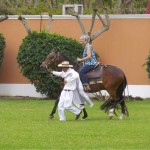Food – “Tell me what you eat…”
 Food - what the locals are eating.
Food - what the locals are eating.
photo of picarones cart in Mira Flores, Lima, Peru
“Tell me what you eat, and I’ll tell you what you are.” Frenchman Brillat-Savarin believed that food had its own story to tell. I agree. Writing, travel and food come together in providing a snapshot of a culture. Eating what the locals eat is the first step in appreciating who they are.
Benny Goldfarb, Private “I” has descriptions of what characters are eating in Colombia. My colleagues often tease me about a chapter making them hungry. That is an unfortunate side effect. I believe that by sharing the same cuisine, I move toward greater cultural appreciation. Speaking the same language also has a similar result. There are concepts couched in speech that have cultural nuances.
What might a citizen of Lima feel on a weekend afternoon in Kennedy Park when enjoying freshly-made picarones, a doughnut-like treat? There’s one way to find out—get in the line at the kiosk, and wait your turn. You will know what generations of Peruvian parents and children have relished.

